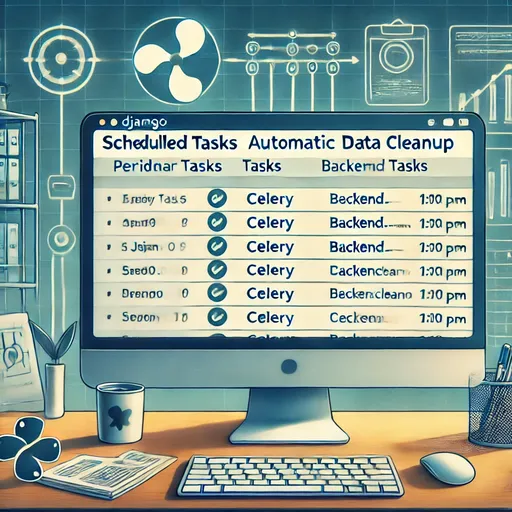Django-celery-beat is a powerful tool that automatically cleans up unnecessary data accumulating in the backend while periodically executing Celery tasks. In this article, we will explore the core concepts and key features of django-celery-beat, particularly focusing on the role and necessity of the celery.backend_cleanup task.
1. Basic Concepts of Django-celery-beat and Periodic Task Scheduling
Django-celery-beat is an extension package that helps execute Celery tasks periodically in Django applications. With this package, you can set up and manage periodic tasks through the Django Admin interface, allowing you to automate scheduling without complex code. Particularly, since you can manipulate the settings for task scheduling through the management page rather than code, it simplifies administration and maintenance.
Tasks that are executed periodically can be set up in various ways:
- Periodic (interval) tasks: Tasks are executed at regular time intervals, such as every minute or every hour.
- Cron tasks: This method executes tasks according to specific days or times. For example, you can set tasks to run at midnight each day.
Django-celery-beat is designed to work with Celery by default, allowing Celery to execute the periodically scheduled tasks. This makes it easy to manage and scale periodic tasks within a Django application and simplifies maintenance.
2. The Role and Necessity of the celery.backend_cleanup Task
One of the tasks that is automatically created when Django-celery-beat integrates with Celery is celery.backend_cleanup. This task is responsible for periodically cleaning up (cleanup) old task data stored in the result backend.
Tasks executed in Celery save the results of the tasks in the backend (result backend). This result data includes the success status and outcomes of tasks; if old data remains in the backend, it can increase the storage size of the backend and lead to performance degradation. To prevent this, Celery uses a periodic cleanup task called celery.backend_cleanup.
Main Roles of celery.backend_cleanup:
- Backend Data Cleanup: The backend where Celery saves task results can use various options such as Redis, RabbitMQ, or databases. If task results continue to accumulate, unnecessary data can build up, leading to performance degradation.
- Performance Maintenance: The
celery.backend_cleanuptask periodically deletes old result data to control the size of the backend and prevent performance degradation caused by unnecessary data. - Automatic Configuration: When integrated with django-celery-beat,
celery.backend_cleanupis automatically added to the Periodic Tasks in Django Admin and is scheduled to run once a day by default.
Thanks to this automatic configuration feature, users can enjoy the benefit of periodic data cleanup in the backend without additional settings.
3. Why celery.backend_cleanup is Automatically Created in Django Admin and How to Manage It
Django-celery-beat automatically schedules celery.backend_cleanup to prevent unnecessary data from accumulating in Celery's result backend. You can see this task registered in the Periodic Tasks of Django Admin, and it is set to run once a day by default. This automatic creation feature is a crucial aspect that reduces the maintenance burden of Celery and helps with performance optimization.
Management Method:
- You can adjust the frequency of the
celery.backend_cleanuptask in the Django Admin > Periodic Tasks menu. - You can disable periodic cleanup tasks as needed or configure them to run more frequently.
- Additionally, it is important to periodically review how often data stored in the backend repository is deleted to find optimal settings for memory management and performance maintenance.
Conclusion
In summary, we explored the basic concepts of Django-celery-beat and the role and necessity of celery.backend_cleanup. In Part 2, we will discuss how django-celery-beat helps manage memory efficiently when configuring a Redis backend.


There are no comments.